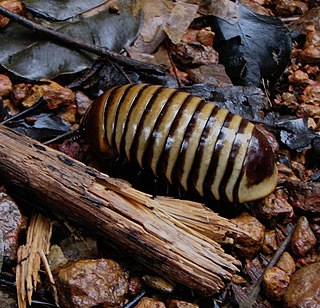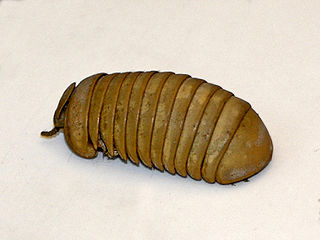
Pill millipedes are any members of two living orders of millipedes, often grouped together into a single superorder, Oniscomorpha. The name Oniscomorpha refers to the millipedes' resemblance to certain woodlice (Oniscidea), also called pillbugs or "roly-polies". However, millipedes and woodlice are not closely related ; rather, this is a case of convergent evolution.

Sphaerotheriidae is a family of giant pill millipedes of the class Diplopoda. Millipedes of this family are distributed in southern Africa.

Glomerida is an order of pill-millipedes found primarily in the Northern Hemisphere. Also known as northern pill millipedes, they superficially resemble pill-bugs or woodlice, and can enroll into a protective ball. They have twelve body segments, 17 to 19 pairs of legs, and males have enlarged rear legs involved in mating. The order includes about 30 genera and at least 280 species, including Glomeris marginata, the common European pill-millipede. The order contains members in Europe, South-east Asia and the Americas from California to Guatemala. Although historically considered closely related with the similar sphaerotheriidans that also enroll, some DNA evidence suggest they may be more closely related to glomeridesmidans, a poorly known order that does not enroll.

Sphaerotheriida is an order of millipedes in the infraclass Pentazonia, sometimes known as giant pill millipedes. They inhabit Southern Africa, Madagascar, South and Southeast Asia, Australia and New Zealand. Like the Northern Hemisphere pill millipedes of the order Glomerida, these millipedes can roll into a ball when disturbed. When they are rolled-up, most sphaerotheriidans reach a maximum size of a cherry or golf ball, but some species from Madagascar can even reach the size of an orange. When rolled-up, predators are unable to unravel giant pill millipedes since the margins of their second and last dorsal plates fit perfectly into one another, creating a sealed ball. A few giant pill millipede species are able to produce sound, the only millipedes known to do this. This order of millipedes is also unique in that some African species are used for medicinal purposes.

Sphaeromimus, or the chirping giant pill millipedes, is a genus of giant pill millipedes endemic to southeastern Madagascar. Though described in 1902, the genus was up to 2005 known from a single male specimen, whose appearance was so unusual that the authors suspected a mislabeled giant pill-millipede from India. Their unusual and distinct morphology includes well-developed stridulation organs, probably as devices for courtship. These are the male ‘harp’ and the female ‘washboard’, which contain more stridulation ribs than in other members of the order Sphaerotheriida. They have a closer affinity with the Indian genus Arthrosphaera than to other Malagasy genera, though all belong to the Arthrosphaeridae.

Zephroniidae is a family of giant pill millipedes in the taxonomic order Sphaerotheriida. They occur in southeast Asia from the Himalayas and China south and east to Sulawesi and to Australia, and also inhabit some Philippine islands.

Glomeridesmida is an order of millipedes in the infraclass Pentazonia containing 2 families and at least 31 species. Glomeridesmida is the only living order of the superorder Limacomorpha. Also known as slug millipedes, glomeridesmidans are small and somewhat flattened, and unlike other orders of Pentazonia, are unable to roll into a ball. Ocelli (eyes) are absent.

Arthrosphaeridae is a family of giant pill millipedes that are found in Madagascar, the Western Ghats of India, and Sri Lanka. The largest pill-millipede in the world, Zoosphaerium neptunus belongs to this family and is known to swarm at certain times of the year.

Zephronia is a genus of giant pill millipedes in the family Zephroniidae. This genus includes 47 species distributed throughout N. India, Myanmar, Thailand, Malayan Peninsula, Java, Sumatra and Borneo.

Glomeris klugii is a species of pill millipede within the genus Glomeris and family Glomeridae. The species is highly variable in colouration, with more than 40 varieties and subspecies identified, each displaying unique colour patterns. The diverse colour patterns of G. klugii can be visually striking, and certain patterns are geographically restricted, leading to the species being associated with numerous taxonomic synonyms.

Glomeris connexa is a species of pill millipede within the genus Glomeris and family Glomeridae.

Trachysphaera is a genus of dwarf pill millipedes in the order Glomerida. Just over 30 species are known, making it the third most species-rich genus of Glomerida. Trachysphaera species are patchily distributed throughout Europe and western Asia, extending from Spain to Caucasia. Members of this genus are tiny, with modified appearances resembling that of calcareous stones.

Zoosphaerium neptunus, also known as the giant emerald pill millipede, is a species of millipede within the family Arthrosphaeridae. Its size is an example of island gigantism, it being the largest known pill-millipede in the world, with some individuals reaching a maximum length of 90 mm long. The species is endemic to Madagascar, where it is known to swarm at certain times of the year. Z. neptunus is the only known species within the order Sphaerotheriida that is known to exhibit this mass swarming behaviour.
Glomeridesmidae is a millipede family of the order Glomeridesmida. This family includes two genera: The genus Glomeridesmus includes most species in this family; the genus Glomeridesmoides includes one species.

Zoosphaerium darthvaderi, also known as the Darth Vader giant pill millipede, is a species of giant pill millipede endemic to the island state of Madagascar. It is named after the Star Wars character Darth Vader. The millipede is restricted to the Ambohitantely Reserve and is considered an extremely endangered species.

Zoosphaerium is a genus of giant pill millipedes endemic to Madagascar. Some species within this genus express island gigantism. The largest of the known species of giant pill millipede known is Zoosphaerium neptunus, which is capable of growing to lengths of 90 mm.

Glomeris sublimbata, also known as the marbled pill millipede, is a species of pill millipede belonging to the genus Glomeris and the family Glomeridae.

Glomeris aurita, also known as the golden-eared pill millipede, is a species of pill millipede belonging to the genus Glomeris and the family Glomeridae.

Glomeris ornata, is a species of pill millipede within the genus Glomeris and family Glomeridae.

Glomeris punica, is a species of pill millipede belonging to the genus Glomeris and the family Glomeridae.


















